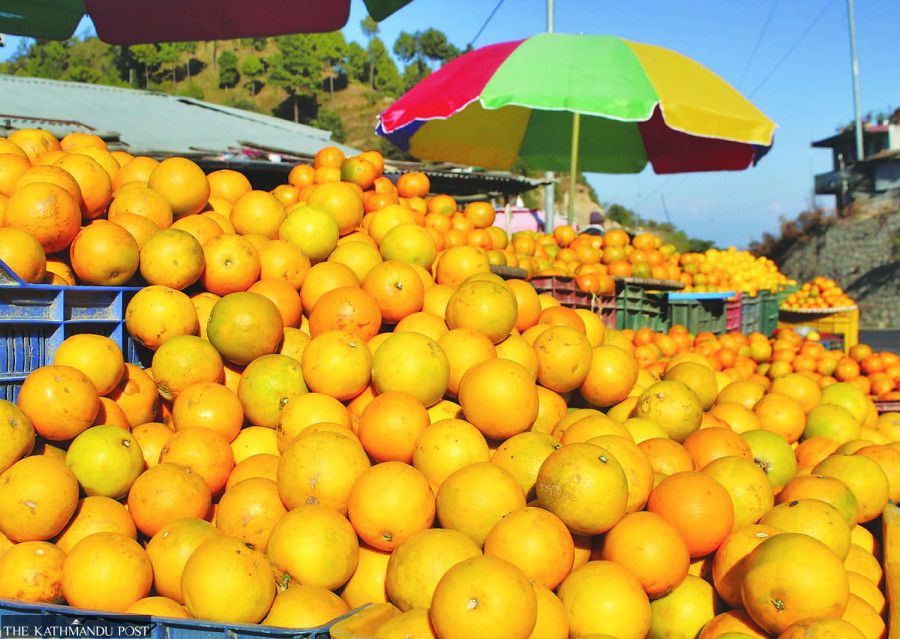Money
Sindhuli farmers expecting bumper sweet orange harvest
The citrus fruit is cultivated on 1,345 hectares in the district; last year, output amounted to 8,881 tonnes.
Raj Kumar Karki
April was a disaster for sweet orange growers in Sindhuli as two hailstorms in a row destroyed the flowers on the crops which were in the sprouting phase.
But five months later, they are quietly relishing the prospect of a bumper harvest.
The citrus fruit is cultivated on 1,345 hectares in Sindhuli which lies in Nepal's eastern midhills. Last year, the district produced 8,881 tonnes of sweet oranges.
Sweet orange or junar trees start bearing flowers in April and farmers start harvesting the fruit in November.
Nirmal Ramtel of Golanjor Rural Municipality, Ratanchura is happy as he had never expected he would be reaping a large harvest this year.
Commercial fruit grower Ramtel had initially thought that there would be zero production. Despite being hit by two severe hailstorms, the sweet orange trees in his orchard are looking good.
"The hailstorm came like it was going to uproot all the trees in my orchard. But the damage was not as bad as we had initially thought," he said.
"Thanks to a good monsoon, my orchard is filled with fruits. I have no words to describe my happiness."
Sweet oranges have a distinctive sweet taste and are rich in Vitamin C and minerals. They are considered to be a special fruit of Nepal as they are rarely found in other countries.
Besides Ramtel, other sweet orange farmers like Bekh Bahadur Ale Magar of Tinkanya is confident of seeing a bumper harvest.
Magar, who is also the local ward chairman, had earned around Rs1.6 million from the sale of sweet oranges last year. This year, he is expecting to double his income.
"Looking at the fruits hanging from the tree branches in the orchard, I am expecting to earn Rs2-2.5 million this year." He said that his neighbours too were seeing an increase in their sweet orange production.
The output in Sindhuli is expected to swell by around 20 percent this year, according to a preliminary estimate.
Due to favourable weather and pest control, except for the hailstorm, fruit production is expected to rise, farmers say.
Farmers said that due to regular and abundant rainfall this monsoon, which extended until October, pests remained under control.
Lok Bahadur Ale Magar, another farmer of Tinkanya, said he had also given up hope of seeing any oranges because of the hailstorms. "But my fruit trees had enough flowers."
Last year, Magar had earned Rs900,000 by selling his sweet orange harvest.
Devraj Adhikari, who heads the Sweet Orange Super Zone under the Prime Minister's Agriculture Modernisation Project, said output has been estimated to increase by 15 to 20 percent this year.
He said there was no pest attack due to abundant rainfall and a regional pest control campaign.
The fruit is cultivated commercially in eight out of the 79 wards in Sindhuli. Ratanchura, Tinkanya, Jalkanya, Bitijor, Basheshwar, Majhuwa and Dumja are the pocket areas for sweet oranges.
Sindhuli farmers earned nearly Rs400 million from their sweet orange crops last year, according to the Sweet Orange Central Cooperative Association.
Out of the total production of 8,881 tonnes last year, 7,500 tonnes was shipped out of the district.
Sweet oranges appear in the market from mid-November to mid-February. Green sweet oranges are also sold during the festive season.
Four years ago, sweet orange production in Sindhuli was negatively impacted by the Chinese citrus fly (Bactrocera minax) that began invading farms in the northern part of the district.
The farmers were in despair after the pest attack ruined their crops. In 2018, 70 percent of the sweet orange crop was lost to the pest. Last year, farmers said pests had damaged around 25 percent of their crops.
The super zone is being expanded following the success in controlling pests.
In Sindhuli, sweet orange is cultivated at altitudes ranging from 800 to 1,300 metres along the Mahabharat range. Sweet oranges produced in the district have a special identity, and are a major source of income for local farmers.




 18.12°C Kathmandu
18.12°C Kathmandu














